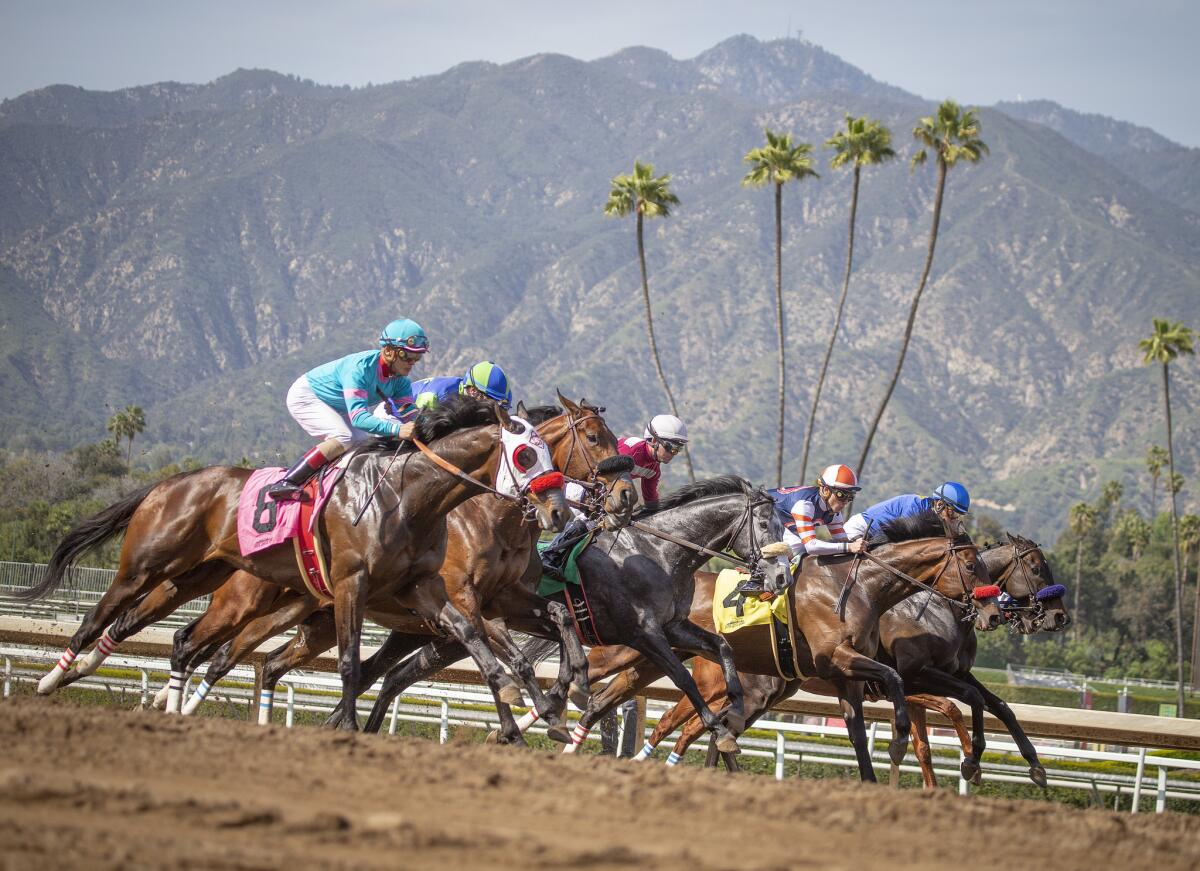Editorial: Will horses finally stop dying at Santa Anita in 2020?

- Share via
If you still need evidence that all those racehorse deaths at Santa Anita Park have shaken people up and created a crisis, consider this: For the first time in 43 years, the park postponed the traditional opening of its winter season from the day after Christmas to the following Saturday. Why? Because it was raining that week. And no one, least of all Stronach Group, which owns Santa Anita Park, wants a repeat of the tragic and alarming spike in deaths during last winter’s heavy rains.
2019 was a tumultuous year for the park. Horses just kept dying — and not just in the rain — even as the public outcry grew louder and the spotlight shone harsher on Santa Anita in particular and on horse racing in general. The Los Angeles County district attorney launched a criminal investigation into the deaths, and animal welfare advocates saw many of the changes they had long called for put into place at Santa Anita, which was desperate to turn things around. Stronach Group instituted groundbreaking reforms, reducing by half the amount of Lasix, a common race-day diuretic, that could be administered to horses and restricting the use of several anti-inflammatory drugs. In a bold move, the park banned Hall of Fame trainer Jerry Hollendorfer after four of his horses died at Santa Anita and two at Golden Gate Fields, which is also owned by Stronach Group.
For the record:
10:30 a.m. Jan. 2, 2020An earlier version of this editorial said incorrectly that the Churchill Downs racetrack was owned by Stronach Group.
A total of 38 horses died at Santa Anita in the past year (the season began at the very end of December 2018). Even with more vigilance and more veterinarians on site and the new drug reforms instituted during the course of the year, the deaths continued.
By the industry metric of racing deaths per 1,000 starts, Santa Anita’s 21 racing fatalities (which doesn’t include training deaths) over 6,892 starts in 2019 works out to a rate of 3.28, according to the California Horse Racing Board. That’s almost double 2018’s industry average of 1.68 (that year, Santa Anita’s rate was 2.04). Other tracks are also facing high numbers. Famed Churchill Downs in Kentucky had a racing death rate of 2.73 per 1,000 starts in 2018.
Although it is true that racing fatalities have declined over the last decade across the nation, the troubling level of fatalities at Santa Anita and elsewhere has focused attention on the need for industrywide reform in the United States. Too many horses are still dying.
L.A. County Dist. Atty. Jackie Lacey’s nine-month investigation into the Santa Anita deaths did not find evidence of criminal animal cruelty. But it did note that toxicology reports revealed that a number of horses that died had a variety of anti-inflammatory drugs, sedatives and muscle relaxants in their systems. Although none were at levels that violated the horse racing board’s rules, it’s troubling that racing, for so long, has allowed horses to train and run — and die — with multiple drugs in their systems. The report also said that the necropsies showed some of the horses had preexisting medical conditions but hadn’t displayed symptoms. (How could they with all those drugs in their systems?) And the report noted that, despite the increased scrutiny of the veterinarians and safety stewards, “racing injuries and fatalities continue to occur.” Santa Anita has now dramatically restricted drug usage and California racing regulators have put those rules into effect for the whole state.
The report made more than two dozen recommendations for racetracks across California, including upping the penalties for violations of California Horse Racing Board rules, installing three different types of scanning machines to help diagnose a horse’s preexisting injuries and canceling racing when rain is heavy. All the proposals are smart and necessary.
Meanwhile, in Congress, the proposed federal Horseracing Integrity Act would establish a much-needed independent, private nonprofit authority to set and oversee nationwide rules on medications. The bill has been co-sponsored by more than half the members of the House but faces a more difficult course in the GOP-controlled Senate.
It will be interesting to see if the reforms at Santa Anita make a difference in horse fatalities. Racetracks have to restrict the rampant and all-too-frequent administration of drugs to horses and overhaul a culture in which some trainers and owners are willing to run an injured horse.
If things don’t change for the better, if death from racing cannot be made rare, the question that will loom large is whether the sport should continue at all.
More to Read
A cure for the common opinion
Get thought-provoking perspectives with our weekly newsletter.
You may occasionally receive promotional content from the Los Angeles Times.










